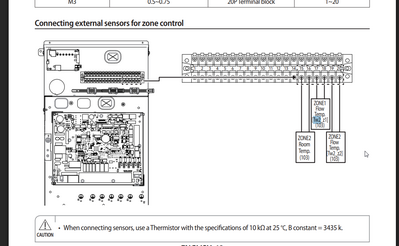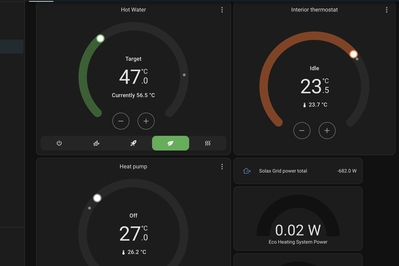Samsung Heat Pump – Can't Activate TW2 Pipe Sensor (for Delta T Control)
Hello all,
I hope someone can help.
I have a Samsung split heat pump installed, outdoor unit AE090RXEDEG, indoor AE200RNWSEG.
Underfloor heating only.
A 100 L buffer is installed, where the out and in water pipes for heating are connected.
There is a recirculation pump mounted on the pipe which is going to the floor distributor.
Heat pump set to work with water law. I believe the pump is oversized for the houses' heat requirements, as it has a lot of on/off cycles.
I wanted to mount one of the external sensor which came with the pump (blue wire one) on the pipe which is leaving the buffer tank.
The problem is I can't seem to figure out where do i connect the wires on the PCB.
According to the manual, this sensor is TW2 - which has to be connected to connector 17 and 18.
I did that but i don't see anything I can change in the service menu to account for it, also in the self test mode, there is no sensor displayed.
The reason why i wanted to add this sensor, is that the difference between water out and in is max 1 degree, even though the delta T is set to 5.
I assume the water from the buffer is cycling between out and in of heat pump, mixing the "hot" and "cold".
I was hoping that by reading this temperature, the DELTA T would actually be close to 5 and heat pump cycling will not be so frequent.
Posted by: @bubuonthewebHeat pump set to work with water law. I believe the pump is oversized for the houses' heat requirements, as it has a lot of on/off cycles.
Posted by: @bubuonthewebI was hoping that by reading this temperature, the DELTA T would actually be close to 5 and heat pump cycling will not be so frequent.
If the house loss is much less than the heat pump min output the heat pump will cycle whatever you do because there is no other way to match the output to the loss. The deltaT will also be lower than the design value of 5, because the loss is lower. I dont know where you are located but where I am its very mild at present so my heat pump is cycling even though well matched to the house loss.
Unless the heat pump controls the speed of the secondary water pump (the one on the emitter side) the deltaT will be determined by the emitters and heat loss anyway, not by the heat pump.
To detect a newly installed sensor you may have to power cycle the heat pump and its controller. Don't forget to leave it off for a minute or more.
Best advice is almost certainly to replumb the buffer (which almost certainly is detrimental) as a 2 port volumiser, but I know that many installers refuse to do this and insist on fitting buffers. 😪
4kW peak of solar PV since 2011; EV and a 1930s house which has been partially renovated to improve its efficiency. 7kW Vaillant heat pump.
@jamespa thanks for the feedback.
I am located in Romania, Arad. Weather is so and so, November - February are below 0 Celsius.
I was hoping that by having the pump read the temp of the water going directly the UFH I could actually find a way to reduce the cycling a bit.
I tried cutting the power multiple times but the sensor is not seen at all...or I can't figure out how to activate it?
Posted by: @bubuontheweb@jamespa thanks for the feedback.
I tried cutting the power multiple times but the sensor is not seen at all...or I can't figure out how to activate it?
I dont know TBH, not a Samsung expert, someone else may.
Posted by: @bubuonthewebI could actually find a way to reduce the cycling a bit.
You can normally increase the period (but with the same on/off ratio) via either a hysteresis setting or a min cycle time in the settings (FSVs in Samsung speal)
Your buffer may be contributing to short cycling if the heat is not being taken away from the buffer by the downstream system. Buffers cause all sorts of problems, really they should only be fitted in exceptional cases.
A large volumiser would also increase the cycling period, but also wont affect the on/off ratio (this is determined by ratio of loss to min output).
Turning the flow temp up may help, it will of course also increase the house temp.
Batch charging is another alternative. If you have a ToU tariff this can be a good strategy otherwise generally not.
I think its unlikely that measuring the buffer temp will do much to change the cycling, but this could be dependent on what feedback loops the Samsung has.
4kW peak of solar PV since 2011; EV and a 1930s house which has been partially renovated to improve its efficiency. 7kW Vaillant heat pump.
@jamespa thanks for the feedback.
Might try and remove the buffer, next year, after the cold season.
Posted by: @bubuontheweb@jamespa thanks for the feedback.
Might try and remove the buffer, next year, after the cold season.
If you do suggest you consider repurposing it as a 2 port volumiser. Secondary pump will also (most likely) have to come out and you may need to change some FSVs. Be aware of any warranty issues though.
4kW peak of solar PV since 2011; EV and a 1930s house which has been partially renovated to improve its efficiency. 7kW Vaillant heat pump.
Wanted to add an update.
As I am running HomeAssistant I added the heat pump through Smart Things app and created a thermostat entity which reads interior temperature from a zigbee temperature sensor and commands the heat pump to turn on or off (did not want to use Samsung's controllers thermostat functionality).
Heat pump is now set on Heat with a fixed water out temp at 27 celsius and Thermostat entity is set at 23,5 celsius (this temperature is suitable for my family)
Created an automation to turn on the heat pump and thermostat at 6 am and turn both off at 8 pm, to have it run only during the day due to solar panel electrical production. This means that if during the night the interior temperature drops below 23,5 the heat pump will not start, as the thermostat entity is inactive.
With this temporary solution, the heat pump runs for a good fews hours continuously at (I think) minimum modulation, until it heats the entire floor. Electrical consumption is around 0,4 - 0,7 kw during the heating period, so no more high number of cyclings.
I plant to add 2 temperature sensors on out/in after the buffer and track those in HomeAssistant also, eventually to include them in an automation for more control, based on water out/in temperature (sensors will be attached to the pipes and insulated).
I am really disappointed in Samsung's limitations on configuring the parameters of functionality to suit individual requirements for specific setups.
PS1: I am more disappointed in myself, as I did not do a proper research before buying the heat pump and listening to inexperienced installers/retailers. An error which cost me 5000 euros 4 years ago. You live and learn 🙂
PS2: I am in the trial period, but until now things look promising, no more cycling every 5-10 minutes. I will post an update after a few weeks.
Hope this helps someone 🙂
@bubuontheweb thanks for the update. There are a lot lurkers on the forums, and I’m sure this will be very helpful to many people looking for similar answers. Thanks again for the update.
Get a copy of The Ultimate Guide to Heat Pumps
Subscribe and follow our YouTube channel!
Very useful to know, and I can feel the pain..
I used home assistant a bit. My setup is a container based mini PC, more like a lab. Given some of the connectors I made need to be secure, I do not skip patches, certificate updates, add-on updates etc. I have some zwave and some WiFi based temperature sensors. My smart things sensor ran out of battery and I haven't got around to it!
Am I guessing right that you keep your HA very stable so it does not need much looking after? And what do you run it on?
16kWh Seplos Fogstar battery; 8kW Solis S6-EH1P8K-L-PLUS hybrid inverter; Ohme Home Pro EV charger; 100Amp head, HA lab on mini PC
@batpred I’m running it on their hardware, HomeAssistant Green and using the HA zigbee receiver. All sensors I have (temp, humidity, presence) are zigbee, most are Sonoff. Everything is quite stable.
The only issues I had were with wifi and matter devices, which are losing connection; this however, is not an issue with HA but with the network and those devices. I plan to move everything to Zigbee, as it seems it’s the most reliable.
I have a modbus connection to HA, for the heat recovery ventilation. This is also very stable.
I am looking into integrating the Samsung heat pump through modbus in HA. I have to study a bit the documentation, to see which parameters are visible and which i can control through modbus. BUT… since Samsung likes to keep a closed ecosystem I have to buy an adaptor from them to have this working, cost is over 500 euro… might buy it for next winter.
Posted by: @bubuonthewebThe only issues I had were with wifi and matter devices, which are losing connection; this however, is not an issue with HA but with the network and those devices. I plan to move everything to Zigbee, as it seems it’s the most reliable.
Zigbee seems stable but not every manufacturer's ZigBee works with other's.
My WiFi already had repeaters and that works well enough on 2.4. I am getting some new matter based bits, just simple WiFi. That'll give the cheap aqara Hub something to do! By the way, the aqara supports smarthings at some level
I have not yet tried anything on modbus.
16kWh Seplos Fogstar battery; 8kW Solis S6-EH1P8K-L-PLUS hybrid inverter; Ohme Home Pro EV charger; 100Amp head, HA lab on mini PC
@batpred For the moment I'm sticking with what I have, as the proved to be reliable.
I'll add an update once some time passes.
- 26 Forums
- 2,364 Topics
- 53.6 K Posts
- 286 Online
- 6,029 Members
Join Us!
Worth Watching
Latest Posts
-

RE: Octopus Cosy Heat Pump Owners & Discussion Thread
TC Thermostatic Radiator Valve TRV Plastic Decorators S...
By Toodles , 2 hours ago
-
RE: Ecodan unable to hit legionella target temp - what's the consensus?
UPDATE: Thanks everyone who commened with suggestions h...
By 9jwr9 , 6 hours ago
-
-
RE: ASHP sizing - value of Heat Transfer Coefficient
@toodles Hi, my friend recently made a video about heat...
By HeatPumpMe , 1 day ago
-

How long will your energy contract last?
Some heat pump tariffs don’t run as long as a heat pu...
By Toodles , 2 days ago
-

@morgan They are unsupervised these days, can’t get the...
By Toodles , 2 days ago
-
-

RE: Setback savings - fact or fiction?
Exactly. We only need to compare conditions, to decide ...
By cathodeRay , 3 days ago
-
RE: Balancing financial efficiency and comfort using the Octopus Cosy tariff
I found because I have very low heat loss I can set bac...
By RadWhisperer , 3 days ago
-
RE: Need Help Optimising My Rushed ECO4 Install: 12kW Bosch Heat Pump
Welcome @mickamills We too have an oversized 12kW Sa...
By Old_Scientist , 4 days ago
-
RE: My Powerwall 3 Consumes 3-4 kWh/Day in Self-Consumption: Is This Normal?
@caron I can confirm that the power usage of the PW3 is...
By Old_Scientist , 4 days ago
-
RE: Speedcomfort radiator fans
Thats true, but having tried (and succeeded) in constru...
By JamesPa , 4 days ago
-
RE: Solis S6-EH1P8K-L-PLUS – Why I Chose It and What I’ve Learned So Far
@bash brilliant, thanks for the feedback
By energy9165 , 4 days ago
-

RE: Heat Pump Heats the House… But It’s Not Cosy. Emitter Changes or System Tweak?
@alastair There I was, feeling grumpy, he said “Cheer u...
By Toodles , 4 days ago
-
RE: Grant Aerona: Is there a setting to keep the 2-port valve open during pump blockade
Depends on OAT. Mine cycles at OAT>10 and of course...
By JamesPa , 4 days ago
-
RE: New Fogstar 15.5kWh upright solution
@transparent My conclusion is as you have noted, tha...
By Bash , 4 days ago
-
RE: Mitsubishi Ecodan R290 10kW performance
And to you too. Wishing you a very enjoyable festive s...
By Sheriff Fatman , 4 days ago
-

RE: External pipework insulation
They do? But that isn't apparent from the photos we'r...
By Transparent , 4 days ago
-

RE: Say hello and introduce yourself
@velcro welcome to the forums. Please feel free start a...
By Mars , 5 days ago
-
Daikin EDLA11D3V3 DHW Settings
I have a newly installed EDLA11D3V3 which I'm still get...
By Velcro , 5 days ago







